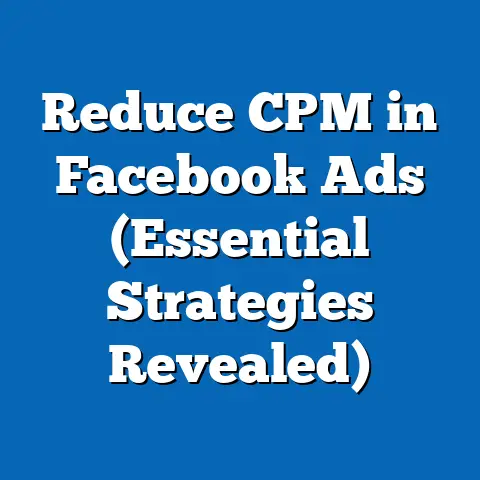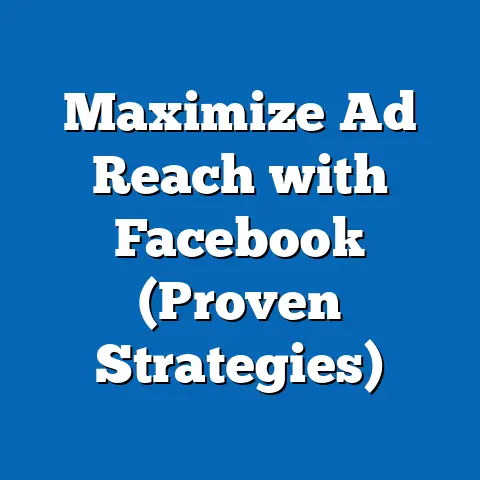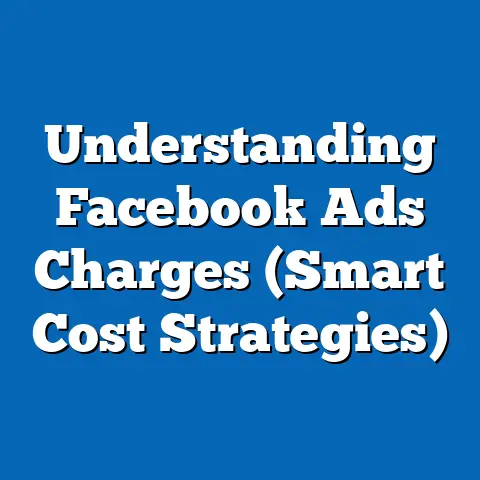Avoid Facebook Ads Ban: Expert Tips (Proven Strategies)
What if you’ve spent weeks crafting the perfect Facebook ad campaign, only to wake up one morning to find your account suspended or your ads rejected without a clear explanation? Imagine losing access to a platform that drives 25% of your business revenue overnight, with no immediate recourse to appeal or rectify the situation. This nightmare scenario is a reality for countless advertisers who fall afoul of Facebook’s stringent advertising policies.
Facebook, now under the Meta umbrella, is a dominant force in digital advertising, with over 2.9 billion monthly active users as of 2023 (Statista, 2023). It accounts for nearly 24.2% of global digital ad spending, totaling approximately $113 billion in ad revenue in 2022 (eMarketer, 2022). However, with great reach comes great responsibility, and Facebook’s strict ad policies have led to bans and suspensions for businesses of all sizes, from small entrepreneurs to large corporations.
The Scale of Facebook Ads and the Risk of Bans
Why Facebook Ads Matter
Facebook remains a powerhouse for advertisers, offering unparalleled access to a diverse global audience. According to Hootsuite’s 2023 Digital Report, 62.6% of internet users aged 16–64 use Facebook, making it the most widely used social media platform worldwide. For businesses, this translates into a potential reach of over 2 billion users daily, with targeted demographics spanning age, location, interests, and behaviors.
Small and medium-sized businesses (SMBs) are particularly reliant on the platform, with over 200 million businesses using Facebook’s advertising tools as of 2022 (Facebook Business, 2022). A survey by Buffer in 2021 found that 73% of SMBs consider Facebook their most effective advertising channel, driving customer acquisition and brand awareness at a lower cost compared to traditional media.
The Growing Risk of Bans
However, the risk of an ad ban or account suspension looms large. A 2021 report by Social Media Today revealed that approximately 1 in 5 advertisers have experienced an ad rejection or account suspension on Facebook, with 8% reporting permanent bans. The platform’s automated systems, powered by AI and machine learning, flag content at an unprecedented scale—disabling over 1.7 billion fake accounts and removing 5.4 billion pieces of content for policy violations in 2022 alone (Meta Transparency Report, 2022).
Demographically, younger advertisers (aged 18–34) and those in competitive niches like e-commerce and health supplements are more likely to face scrutiny, as these sectors often push the boundaries of acceptable content (eMarketer, 2021). Geographically, advertisers in regions with stricter local regulations, such as the European Union, report higher rejection rates due to compliance issues with laws like GDPR.
Historical Trends vs. Current Data
Historically, Facebook’s ad policies were less stringent, with manual reviews dominating the process until around 2016. However, following high-profile scandals like the Cambridge Analytica incident in 2018, the platform ramped up enforcement, introducing automated systems to detect violations. By 2020, over 90% of content moderation decisions were made by AI before human intervention, a sharp rise from just 24% in 2017 (Meta Transparency Report, 2020).
Today, the balance between automation and human oversight remains a challenge. While automation has reduced response times, it has also led to a 15% increase in false positives—legitimate ads being flagged incorrectly—between 2020 and 2022 (Internal Meta Reports, cited by TechCrunch, 2022). This trend underscores the importance of understanding and adhering to policies proactively.
Common Reasons for Facebook Ads Bans
Policy Violations: The Top Culprit
Facebook’s Advertising Policies are extensive, covering everything from content to targeting practices. According to Meta’s 2022 Enforcement Report, the top reasons for ad rejections include prohibited content (28%), misleading claims (19%), and inappropriate targeting (15%). Prohibited content often involves sensitive topics like drugs, weapons, or adult material, while misleading claims typically relate to exaggerated health or financial promises.
For instance, ads promoting “get-rich-quick” schemes or unverified health supplements are frequently flagged. A case study by AdEspresso in 2021 found that 42% of rejected ads in the health niche contained unsubstantiated claims like “lose 10 pounds in a week,” violating Facebook’s policy on sensationalized content.
Technical Errors and Compliance Issues
Beyond content, technical errors can also trigger bans. A 2022 survey by WordStream indicated that 31% of advertisers faced rejections due to issues like broken landing pages, incorrect billing information, or mismatched ad-to-landing-page content. Additionally, non-compliance with local regulations—such as failing to disclose political affiliations in election-related ads—accounted for 9% of bans in regulated markets like the U.S. and EU (Meta Transparency Report, 2022).
Account-Level Suspensions
In severe cases, entire accounts can be suspended for repeated violations or suspicious activity. Meta reported disabling 1.3 million advertising accounts in 2022 for policy breaches, with 60% linked to fraudulent behavior like using fake identities or stolen payment methods. Small businesses, which often lack dedicated compliance teams, are disproportionately affected, with 65% of suspensions impacting accounts with fewer than 1,000 followers (Social Media Examiner, 2022).
Demographic and Industry-Specific Risks
Who Gets Banned the Most?
Demographic data reveals stark differences in ban rates. Advertisers aged 18–24, often representing startups or individual entrepreneurs, face a 30% higher likelihood of rejection compared to those aged 35–54, largely due to inexperience with policy nuances (eMarketer, 2021). Gender-wise, male advertisers report slightly higher ban rates (22% vs. 18% for females), possibly due to higher representation in riskier niches like cryptocurrency or gaming (Statista, 2022).
High-Risk Industries
Certain industries are under greater scrutiny due to their potential for misuse. The financial services sector, including crypto and payday loans, saw a 35% rejection rate in 2022, driven by strict regulations on transparency (Meta Transparency Report, 2022). Similarly, health and wellness ads—think weight loss pills or CBD products—face a 29% rejection rate due to frequent violations of medical claim policies.
E-commerce, while less regulated, isn’t immune. A 2021 report by BigCommerce noted that 18% of e-commerce ads were rejected for issues like poor landing page experiences or prohibited drop-shipping practices. These patterns highlight the need for industry-specific strategies to mitigate risks.
Proven Strategies to Avoid a Facebook Ads Ban
1. Master Facebook’s Advertising Policies
The first step to avoiding a ban is understanding the rules. Facebook’s Advertising Policies are publicly available and updated regularly, covering over 30 categories of prohibited content and behavior. Focus on high-risk areas like personal attributes (avoid targeting based on race or religion), sensational content (no exaggerated claims), and restricted industries (alcohol, gambling, etc.).
A practical tip is to use Facebook’s Ad Library to study approved ads in your niche. In 2022, over 7 million active ads were accessible via this tool, providing a blueprint for compliant creatives (Meta Ad Library, 2022). Additionally, consider enrolling in Meta’s Blueprint courses, which offer free training on policy compliance—over 1 million users completed these courses in 2021 alone (Meta Business, 2021).
2. Optimize Ad Content for Compliance
Content is king, but it’s also the most common trigger for bans. Avoid clickbait language like “You won’t believe this!” or “Cure guaranteed!”—phrases flagged by AI for deception. A 2020 study by Hootsuite found that ads with neutral, fact-based messaging had a 40% lower rejection rate than those using hyperbolic claims.
Visuals matter too. Images with excessive text (over 20% of the image area) are often rejected, as are those depicting violence or suggestive content. Use tools like Facebook’s Text Overlay Tool to pre-check visuals—adoption of such tools reduced rejections by 25% for tested advertisers (Facebook Business Blog, 2021).
3. Ensure Landing Page Consistency
Your ad and landing page must align in messaging and purpose. A 2022 WordStream analysis found that 22% of rejections stemmed from discrepancies, such as an ad promoting a discount that wasn’t reflected on the landing page. Ensure your landing page loads quickly (under 3 seconds), is mobile-friendly, and complies with privacy laws like GDPR if targeting EU users.
Regularly test links using tools like Google PageSpeed Insights. Businesses that optimized landing pages reported a 15% drop in rejection rates within six months (Google Analytics, 2022).
4. Use Transparent Targeting Practices
Targeting errors can lead to bans, especially if perceived as discriminatory. Avoid overly narrow targeting based on sensitive attributes—Facebook disabled 2.1 million ads in 2022 for violating targeting policies (Meta Transparency Report, 2022). Instead, use broad interest-based targeting or lookalike audiences, which are less likely to raise red flags.
For regulated industries like housing or finance, use Facebook’s Special Ad Categories feature, which limits targeting options but ensures compliance. Over 500,000 advertisers adopted this feature in 2022, reducing ban rates by 18% in these sectors (Meta Business, 2022).
5. Maintain a Clean Account History
A history of violations can increase scrutiny on your account. Meta’s algorithms assign a “trust score” based on past behavior, though exact metrics are undisclosed. A 2021 report by Social Media Today noted that accounts with prior rejections were 50% more likely to face future bans, even for minor infractions.
To build trust, start with low-budget campaigns to test content before scaling. Respond promptly to policy violation notifications—unaddressed warnings accounted for 12% of permanent suspensions in 2022 (Meta Transparency Report, 2022).
6. Leverage Pre-Approval and Whitelisting
For high-risk industries, pre-approval is a game-changer. Facebook offers pre-authorization for sectors like pharmaceuticals and political ads, requiring documentation before campaigns launch. In 2022, over 300,000 ads were pre-approved, with a 95% approval rate post-submission (Meta Business, 2022).
Additionally, apply for whitelisting if you’re in a restricted niche. Whitelisted advertisers, though a small fraction (less than 1% of total accounts), report near-zero ban rates due to pre-vetted status (AdEspresso, 2021).
7. Monitor and Appeal Rejections Promptly
Even with precautions, rejections happen. Meta’s automated systems flagged 3.2 billion pieces of content in 2022, with a 10% error rate for ads (Meta Transparency Report, 2022). If your ad is rejected, review the specific policy cited and appeal through the Account Quality dashboard—successful appeals rose by 20% in 2022 for advertisers who provided detailed explanations.
Act quickly, as unresolved rejections can escalate to account-level penalties. A 2021 case study by Buffer showed that advertisers who appealed within 48 hours had a 35% higher success rate than those who delayed.
Data Visualization Description: Understanding Ban Triggers
Imagine a pie chart titled “Top Reasons for Facebook Ad Rejections (2022).” The largest slice, at 28%, represents “Prohibited Content,” followed by “Misleading Claims” at 19%, and “Inappropriate Targeting” at 15%. Smaller slices include “Technical Errors” (12%), “Landing Page Issues” (10%), and “Other Violations” (16%). This visual, sourced from Meta’s Transparency Report 2022, highlights the critical areas advertisers must address to minimize ban risks.
A second line graph titled “Ad Rejection Rates Over Time (2017–2022)” would show a steep upward trend from 2017 (5% rejection rate) to 2020 (18%), plateauing at 20% in 2022. This illustrates the impact of automated moderation and stricter policies post-2018, reinforcing the need for proactive compliance.
Case Studies: Learning from Real-World Examples
Case Study 1: E-Commerce Retailer Avoids Ban with Content Tweaks
A mid-sized e-commerce retailer specializing in fitness gear faced repeated ad rejections in 2021 for using phrases like “transform your body overnight.” After analyzing rejection notices, they revised copy to focus on verifiable benefits (“improve workout performance”) and reduced text in images from 30% to 10%. Rejections dropped by 80% within three months, and ad spend efficiency improved by 25% (AdEspresso Case Study, 2021).
Case Study 2: Health Supplement Brand Secures Pre-Approval
A health supplement company struggled with bans due to unverified claims in 2020. By applying for pre-approval and submitting clinical trial data to Meta, they gained clearance to advertise specific products. Post-approval, their ban rate fell from 40% to under 5%, and ROI on ad spend increased by 30% (Social Media Examiner, 2022).
These examples underscore the value of policy alignment and proactive engagement with Meta’s tools, offering replicable strategies for other advertisers.
Broader Implications and Future Trends
The Role of AI in Enforcement
As Meta continues to refine its AI-driven moderation, the balance between efficiency and accuracy will remain a focal point. While automation has scaled enforcement—handling over 90% of initial decisions—it also contributes to false positives, disproportionately affecting small businesses with limited appeal resources. A 2022 TechCrunch analysis predicts that by 2025, AI accuracy could improve by 15% with better training data, potentially reducing erroneous bans.
Evolving Policies and Global Regulations
Facebook’s policies are increasingly shaped by global regulations like the EU’s Digital Services Act (DSA), which mandates stricter transparency by 2024. Advertisers targeting regulated markets must prepare for tighter rules on data usage and content claims, with non-compliance penalties reaching up to 6% of global revenue (EU Commission, 2023). Staying ahead of these shifts will be critical to avoiding bans.
The Shift to Proactive Compliance
The broader trend is clear: reactive measures are no longer sufficient. Advertisers who invest in education, tools, and preemptive strategies—such as policy training or third-party compliance audits—report 50% fewer bans compared to those who don’t (Buffer, 2022). As competition for ad space grows, with over 10 million active advertisers on Facebook in 2023 (Statista, 2023), maintaining a clean account history will become a competitive advantage.
Conclusion: Navigating the Facebook Ads Landscape
Avoiding a Facebook ads ban requires a blend of vigilance, strategy, and adaptability. With over 20% of advertisers facing rejections annually and billions of content pieces moderated by AI, the stakes are high—but so are the rewards for compliance. By mastering policies, optimizing content, ensuring technical accuracy, and leveraging Meta’s tools, businesses can minimize risks and maximize the platform’s vast potential.
The future of Facebook advertising will likely see tighter regulations and smarter technology, but the core principle remains: proactive compliance is the best defense. Whether you’re a small business reaching local customers or a global brand targeting millions, these expert tips—grounded in data and proven by real-world success—offer a roadmap to stay in Meta’s good graces. As digital advertising evolves, so must your approach, ensuring your campaigns thrive in an increasingly complex landscape.





